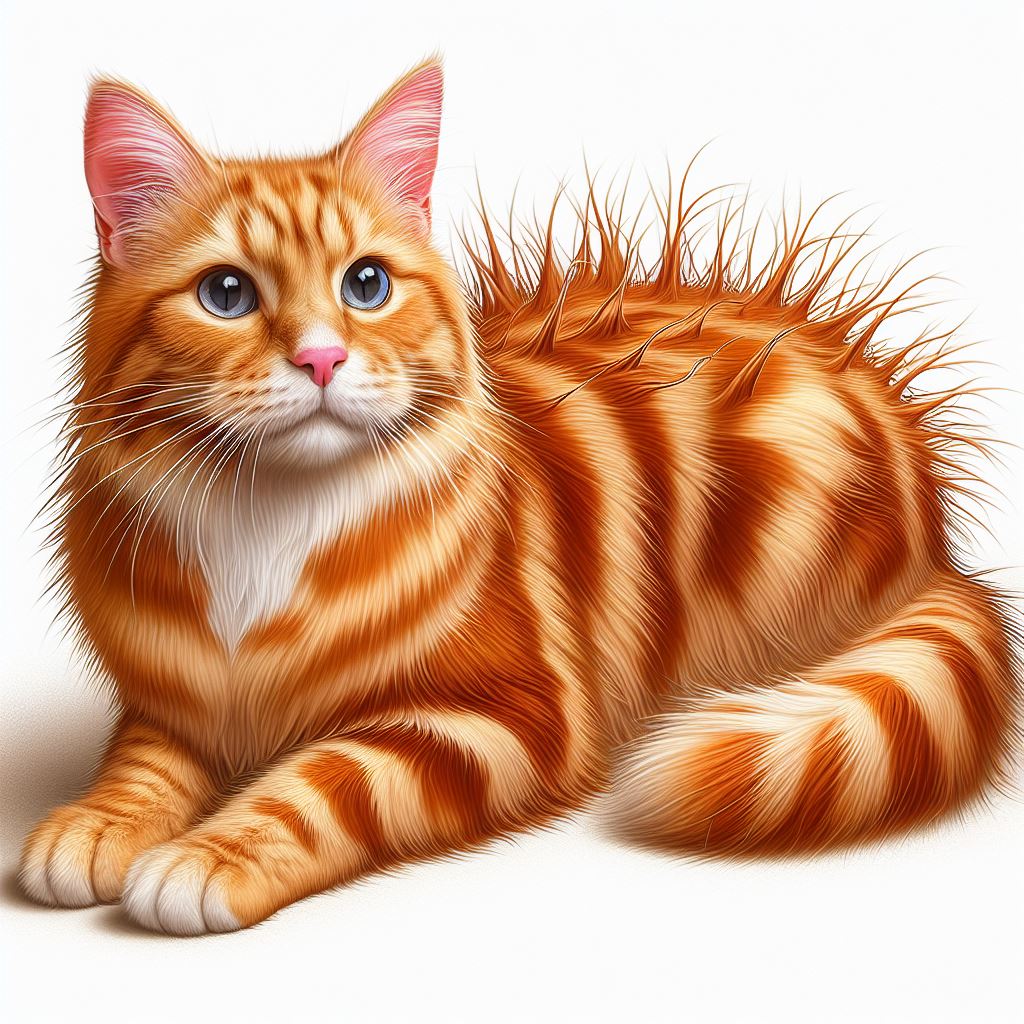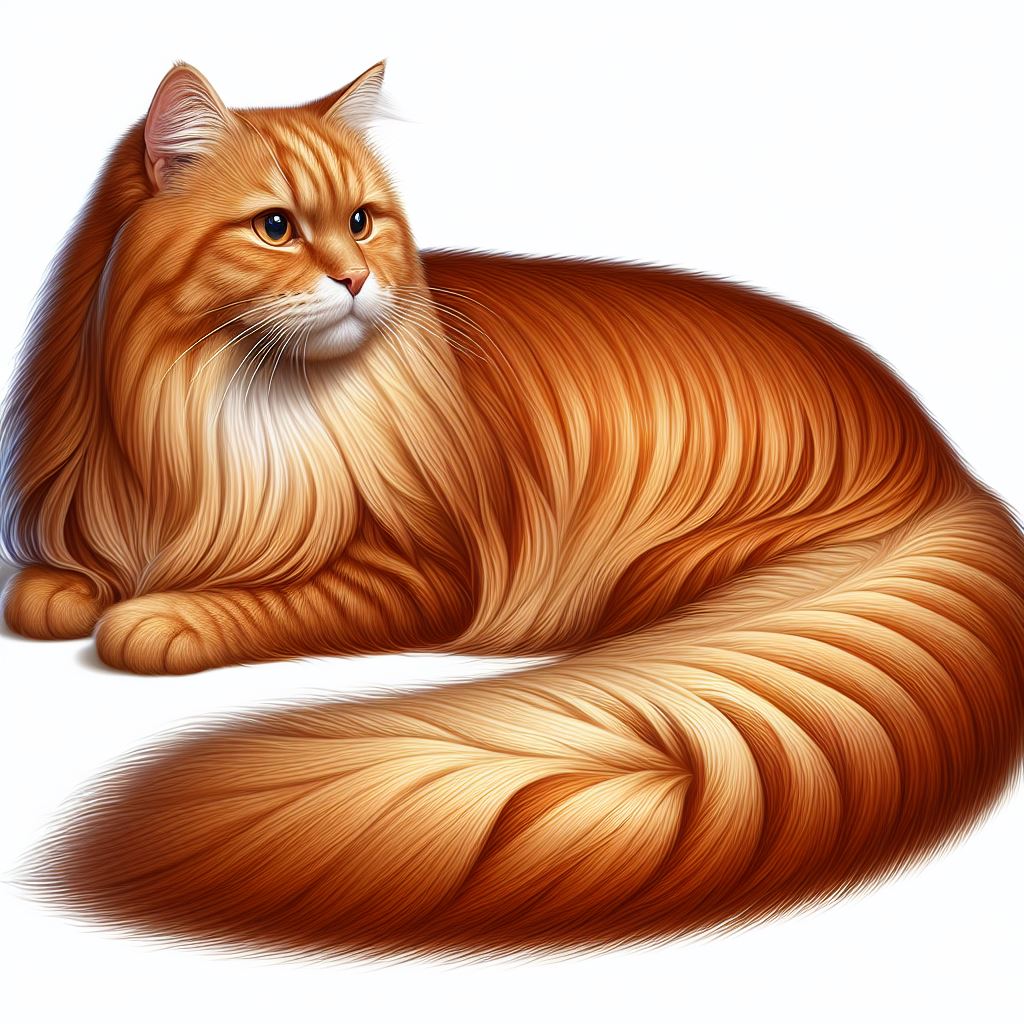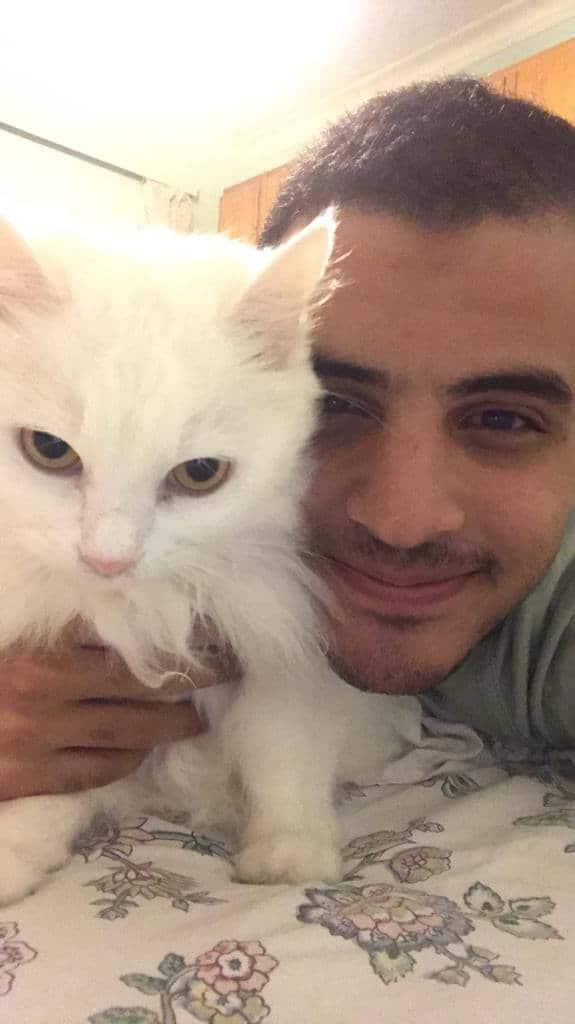Have you noticed your cat’s fur looking clumpy or not smooth? It’s like the strands are sticking together in patches. This can be confusing, right? Well, it’s called a ‘staring coat’ in cats.
In this article, we’ll figure out why this happens and what you can do about it. We’ll explore reasons like shedding and health stuff that might be making your kitty’s fur look different. Let’s dive into understanding your cat’s fur and how to keep it looking and feeling great!
Table of Contents
What is a Separated or Staring Coat in Cats?
Staring coat in cats refers to a condition where the tips of their fur begin to stick together, often caused by an accumulation of grease. Instead of a smooth, sleek appearance, the hair separates into rows or small clumps, resulting in a spiky, clumped look to the coat. This texture change makes the fur appear uneven and disjointed, altering the usual sleek appearance of a cat’s coat.
My Cat’s Fur Looks Separated: Why and What Should I Do?
The cat’s fur might look separated if it’s sick, old, or not eating well. Infections and parasites can also cause the coat to look clumpy and separated.
Bathing and brushing the coat regularly will keep it in perfect shape. You should also consult the vet to detect any problem before it gets worse.
Related: Why is my cat losing hair on its tail tip?
why is my cat’s fur separating?

As a cat owner, you’re probably aware that cats are fond of grooming themselves. And every time your feline licks itself or rolls its body in the dust, it’s cleaning the coat to retain its shine and smoothness.
On some occasions, you might notice that the coat is looking separated or clumpy. It also doesn’t feel smooth to touch for several reasons.
- The main reason behind a clumpy or separated coat is poor nutrition. Your feline will have a shiny and healthy coat if it’s eating a balanced diet of proteins, carbohydrates, fats, and all the needed minerals and vitamins.
On the other hand, if your cat is eating a poor diet or not eating enough, its coat will show signs of separation because the hair follicles are falling or sticking together.
- You might not be offering your cat the correct type of food. If you have a kitten or a senior cat with a specific health issue, their needs might be different from a healthy adult cat.
This is why you need to think about their changing dietary and nutrition needs, making sure that they can digest the food and benefit from all the nutrients you provide.
- If your cat is overweight, its coat might become clumpy. This is because cats always groom themselves, but they become unable to reach every part of their bodies when they gain weight. As a result, some parts of the coat can become separated or clumpy.
- Stress and anxiety will affect the cat’s overall health, including its coat. If your cat is highly stressed or suffering from a trauma, it might start losing its coat.
- Mouth injuries and dental problems can prevent the cat from properly grooming itself. The cat uses its tongue to groom itself regularly, spreading the oils evenly across the coat and removing dander and dead hairs. When there’s a problem with the tongue or the mouth, your pet won’t be able to do this job the way it should.
- If you have an older cat that suffers from arthritis or any joint problem, it might not be able to twist and turn enough to reach every part while it’s grooming its body.
- Hormonal imbalances can affect the look of the coat. Older cats that were not spayed are more likely to suffer from these issues, and they’ll make the coat look separated.
- Your cat might be suffering from a disease that increases oil production in its skin. The skin produces enough oils to nourish the skin and keep the furry coat in perfect condition, but when there’s too much oil, the hairs are going to stick together, giving the coat a separated look.
- Skin infections, parasites, allergies, and autoimmune diseases can cause the coat to become too clumpy and sticky. If you don’t get your feline treated, it might lose its hair, and you’ll see bald patches on the coat.
- Other infections like gut diseases, diarrhea, worms, and cancer will change the cat’s coat because they affect the pet’s overall health.
- In some cases, you might be the culprit behind the cat’s coat getting too sticky. For example, if you bathe your feline too often to control a flea infection or too much dandruff or if you use the wrong products while bathing your cat, you might damage the coat, and it will become too sticky.
- Changes in the weather can affect the quality of the coat. For example, the cold winter air or too much humidity can make the coat lose its shine and become too dull and sticky.
What Does Healthy Cat Fur Look Like?

You might not know what’s wrong with your cat, so it’s important to understand what a healthy coat looks like.
Ideally, the cat’s coat should be smooth to touch. It should look shiny with some rough yet rich texture, and it should completely cover the skin if you don’t manually separate it. The coat should also be thick enough to keep the cat’s body warm.
If you manually separate the hair to take a look at the cat’s skin, it should be smooth and well-hydrated. If the skin looks too dry or flaky with too much dandruff, then there’s something wrong with your pet. If the skin also looks too greasy, or you see red bumps or pimples, then your cat might be suffering from a skin infection.
Related: What Are Those Black Spots Around My Cat’s Bum?
How Can I Fix My Cat’s Clumped Coat?
If the vet checks your cat and tells you that there’s nothing wrong with it, you can do a few things to keep the coat in the best shape. In most cases, cats don’t need help with grooming, but long-haired cats might need some intervention because the hair gets tangled.
Moreover, if your cat is sick or too old, it might not be able to groom itself the way it should. As a result, you might need to step in to keep the coat in the best shape. Here’s what you need to do.
- Make sure to wear some heavy-duty gloves while grooming your pet. Your cat might get a little resistant or even aggressive when you’re trying to de-mat the coat, so you need to protect your hands. Moreover, your pet might suffer from skin or parasitic infections, so it’s better not to touch the skin directly.
- Grab a dematting comb and try to approach your cat when it’s relaxed, so it can be less resistant to touch. Working with adult cats is more challenging, especially if your feline had a previous unpleasant experience while being groomed or touched.
- If you can’t handle the cat by yourself, ask a friend for help. They can gently hold the cat while you’re trying to remove the tangles and knots from the coat to smooth it out.
- If you’re unable to hold the cat and it becomes too aggressive, hire a professional groomer instead. While combing your cat’s fur shouldn’t be challenging, a groomer will know how to comfort it and finish the job in less time. Moreover, combing the fur can become extremely uncomfortable and even painful for your pet with too many knots.
- Using a humidifier might help your pet cat if it suffers from a separated coat at specific times of the year. A humidifier will increase the level of humidity and moisture in your house if the weather is too dry for your feline. As a result, it can reduce the flakiness of the skin and the clumpiness of the fur.
- To maintain the healthy look of the cat’s coat, brush it frequently. This will help remove any loose hair before forming knots that can be too painful to remove.
Brushing also helps distribute the natural oils that moisturize the skin and keep the fur in perfect shape. If you have a short-haired cat, you might need to brush it only once a week, but a long-haired cat needs to be brushed every single day.
- Pay attention to the cat’s needs to schedule bathing and professional grooming. For example, a young cat that grooms itself regularly might need one or two baths per year. However, if you have an old or sick pet that is unable to reach every part of its body to groom it properly, you’ll have to bathe it more frequently.
- When you’re bathing your cat, make sure that you’re using a hypoallergenic shampoo that’s specifically designed for cats. Soaps and shampoos that are made for humans can be too harsh on the cat’s delicate skin and might cause hair loss or skin infections.
- Use a small amount of olive oil or coconut oil to massage the cat’s skin after the bath. The oil will help trap the moisture and reduce the amount of dandruff and scaly flakes on the cat’s skin. It will also restore the shine to the coat and help it grow healthily.
- Inspect the cat’s coat daily for any knots or clumps. This will prevent tangles from forming and becoming too difficult to remove. You’ll also be able to detect any lumps or bumps on the skin.
Ever wondered what are those black spots on your cat’s nose? read or article to learn more.
What If My Cat Is Overgrooming Itself?
Your cat overgrooming itself and licking itself all the time is just as bad as under-grooming itself. The cat’s tongue is a little rough, and when it licks its body excessively, it might accidentally injure itself.
Overgrooming is usually a sign that your cat is suffering from a parasitic infection or another skin problem. As it licks itself, it’s simply scratching its body to relieve the pain.
When the irritation persists, your feline might start to nibble or even bite the infected area. As a result, it might harm its skin and accidentally remove the hair from some spots, so it will have some bald patches on the coat.
When this happens, you should consult the vet. He or she will examine your pet and prescribe the needed medication. In most cases, using flea shampoo and following the right application schedule will solve the problem and eliminate the parasitic infection.
Will the Separated Fur Harm My Cat?
While having a shiny and healthy, smooth coat indicates that your cat is healthy, a sticky and separated coat is more than just a change in the cat’s look.
A separated coat where the hairs are sticking together can indicate a serious health problem that your feline is suffering from. This is why you need to have your cat checked, and the vet will prescribe an appropriate medication before the problem gets worse.
Due to the buildup of dead hair and dander, flea infestations will become more serious. This is why your pet might be more prone to these, and they can eventually kill your feline if left untreated.
At the same time, the separated coat indicates that it’s unable to perform the job of protecting the cat’s body from the elements and parasites. As a result, your cat will be more prone to parasitic and skin infections and will feel colder in winter because it lacks adequate protection.
So, while a separated coat isn’t a serious health issue on its own, it can affect the cat’s health and reduce the efficiency of the coat’s protection and insulation functions.
Wrap Up
A separated, staring coat in cats almost always indicates an underlying issue, whether it’s shedding season, poor nutrition, illness, or something else. While not inherently dangerous, it does mean your cat’s fur cannot properly regulate body temperature and protect against external parasites.
The good news is that most causes of coat separation can be addressed with some diligent care and attention on your part. Make nutritious, species-appropriate food a priority, brush frequently to distribute oils and remove loose hairs, establish a low-stress home environment, and schedule regular vet checkups.
With a commitment to your cat’s health and some extra TLC, you can get their coat looking smooth, shiny, and protected in no time. But if symptoms persist or you notice any concerning changes, don’t hesitate to call your vet right away – a staring coat can indicate disease if left untreated.

I’ve been living with cats since 2008 and I can confidently say I have more feline friends than humans lol. I currently live with 5 cats in different life stages; two of them are less than one year old, one is 2-ish years old and the oldest two are 9-ish years old. I’ve developed a strong bond with cats over the years and I’m eager to share my experience through this blog. You can learn more about my cats here.


![PetFusion Multipurpose Pet Glove for Grooming, Trips to Vet, Handling. [Puncture & Scratch Resistant, Water Resistant]. 12 Month Warranty for Manufacturer Defects PetFusion Multipurpose Pet Glove for Grooming, Trips to Vet, Handling. [Puncture & Scratch Resistant, Water Resistant]. 12 Month Warranty for Manufacturer Defects](https://m.media-amazon.com/images/I/41sY8zQgHoL._SL500_.jpg)